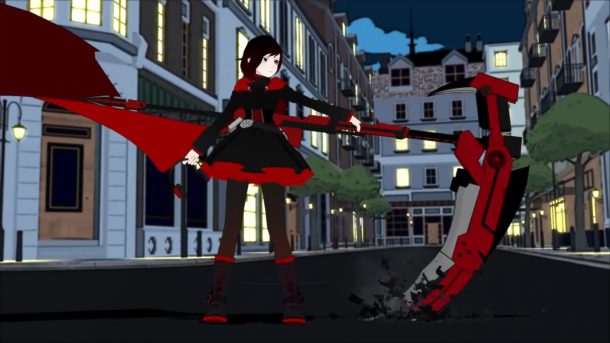As usual, I am fashionably late.
I started my (re)watch of RWBY shortly after Rooster Teeth announced they were shutting down, but it took me until August to actually finish it. A regular binge watcher, I am not. I decided I wanted to do a post on RWBY pretty much as soon as I started the rewatch. It’s a bit outside my usual content, but RWBY was a huge influence on me as a creator, and I think there are at least a few lessons to take away from it.
For now, I’m just going to go volume-by-volume with some brief thoughts on each, written up more or less right after I watched each one. I’ll sort of sum things up at the end, but deeper analysis and further reflection will have to wait for the next articles in the series.
Spoilers? I don’t go into a lot of detail, but describing the later volumes at all spoils the earlier ones, at least a little.
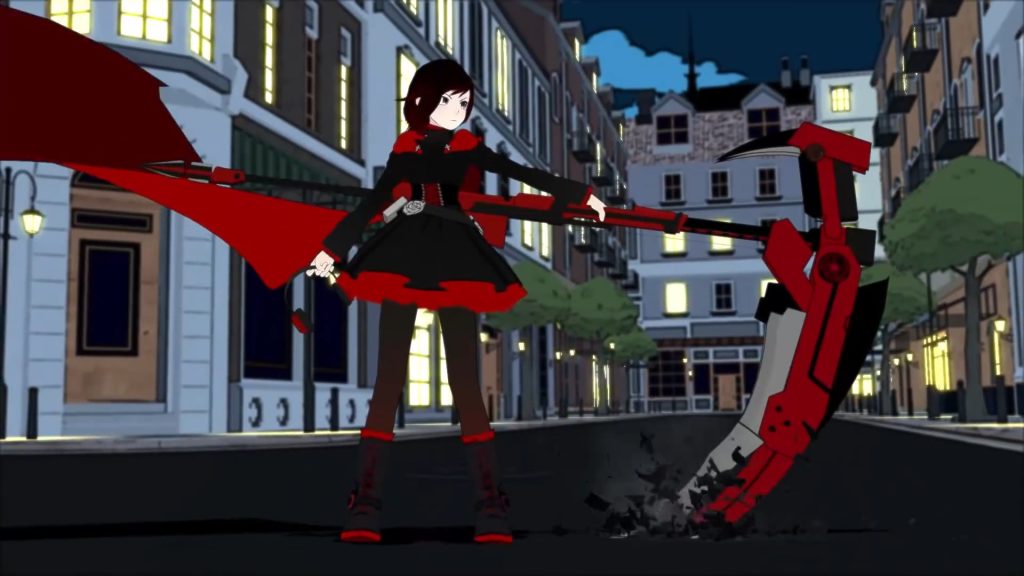
Volume 1
The good: Charming in a “made by three people in a basement” kind of way. Fun characters and designs. Monty’s fight choreography.
The bad: Janky in a “made by three people in a basement” kind of way. Terrible pacing and a split focus on two teams when there was barely time for one. Tries to do An Aesop on racism, but it’s ham-fisted by 2013 standards, let alone 2024 ones.
The ugly: Alpha Jaune’s abridged version will forever colour my perception of V1.
Better on a binge rewatch? Probably, but I didn’t watch it when it first came out, rather a year later with V2 around the corner, so I can’t say for sure. It helps offset the short, inconsistent episode length.
The first volume is extremely janky and obviously low-budget, much more so than I remember. It feels oddly representative of its era in that way; while later volumes could have been made today, the first one feels like an early-2010s internet passion project, sitting right on that transition between hobbyist fanworks and slick, professional productions (and if my Rooster Teeth history is correct, which it probably isn’t, made by people making that transition themselves).
Let’s be honest, it’s objectively not very good, with often-iffy animations, weird looking models, amateurish writing and incredibly short episode runtimes. However, all the strong points that I really love the series for- fun characters, bold designs, great music, and epic fight scenes- are already on display here. It suffers from a split storyline and a weird focus on what was initially presented as a side character, but these stories probably resonated with the teen to young adult audience of the time. I know they resonated with me. What Volume 1 lacks in tangible quality it makes up for with intangible charm.
Volume 2
The good: Much less janky and low-budget than Volume 1. The dance scene. Introduces or gives the first significant screen time to fan-favourite characters. A few really good character moments.
The bad: Forgettable plotline that sorta leads somewhere but also kinda doesn’t. Less janky doesn’t mean not janky.
The ugly: I forgot how aggressively hetero this show was given its massive LGBT fanbase.
Better on a binge rewatch? Maybe. There are a lot of cliffhangers and binging it kills the suspense, but also keeps the pace up.
I barely remembered Volume 2. Volume 1 and Volume 3 I remember well, but not Volume 2, and I’ve already all but forgotten it between rewatching it and writing this piece. It’s a massive improvement over Volume 1 in every meaningful way, but I think it gets overshadowed by the even better and much more narratively significant Volume 3.
Still, there are some cool sequences and great character moments, even if the overall plot meanders a lot. It toys with some deeper ideas and darker moments, but overall retains a very similar feel to V1, just with, y’know, way less jank. It’s clear that the show is still trying to find its footing at this point, but paradoxically, also feels the most representative of what we’d call the early RWBY, when it leans on comedy, the stakes are relatively low, and rule of cool reigns supreme. It’s fast, it’s fun, it’s still not super serious and it’s still pretty rough around the edges.
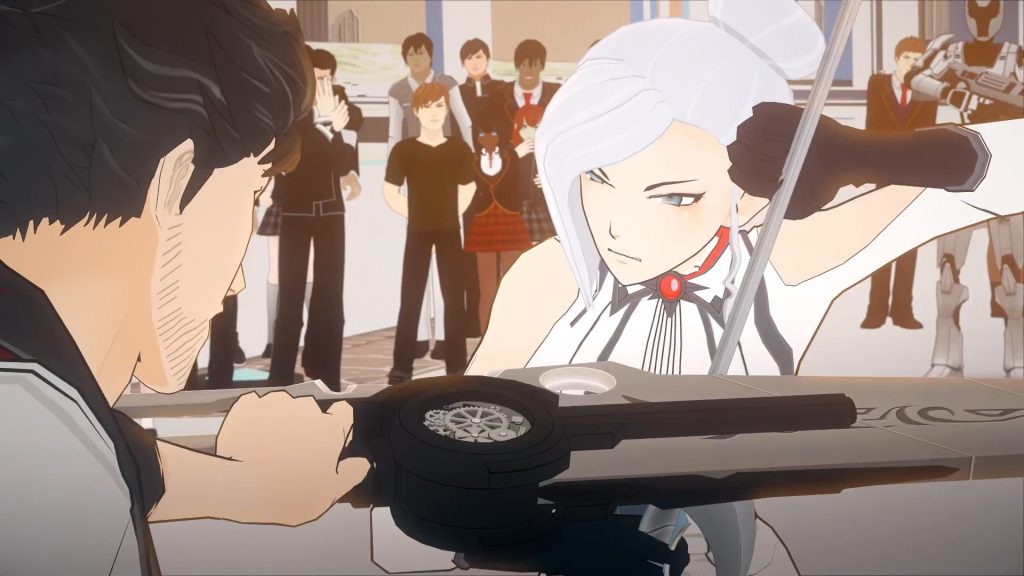
Volume 3
The good: Production values continue to improve. Great music, character designs, and fight scenes. Introduces lore but mostly avoids dumping it too fast. Conclusion really raises the stakes.
The bad: Weird pacing when watched episodically. Excessive character count, many one-off.
The ugly: Did they base a team on internet memes?
Better on a binge rewatch? Definitely. It felt weirdly paced when I watched it the first time around, but much smoother when watched in a session or two. It’s a pretty long “movie” by this point but it never felt bogged down.
I remember being pretty ambivalent about Volume 3 the first time around, but I was surprised by how much I liked it on a rewatch. I think watching it all at once helped- at the time I found it weirdly paced and felt it spent too much of its runtime on largely inconsequential fight scenes, but when watched all together as a movie it comes together much better.
The first two thirds are slower, but still engaging, while the last third is an absolute whirlwind. Taken on its own Volume 3 is good, but in its last act begins the shift from a light, fluffy show to something more serious, and how that gets followed up on in subsequent volumes is the sticking point. I honestly struggle to find any issue with this volume itself that are significant enough to mention, let alone really dig into. That’s not to say it’s perfect, and its production values aren’t anywhere close to the heights the series would eventually hit, but I think it’s the volume that does the best job of nailing what it set out to do.
Volume 4
The good: A step up in visual effects (they discovered shaders?). Some good character moments. We get to see the villains up close. Well-written, emotional ending monologue. Introduces some key lore.
The bad: Slow-paced and boring. Doesn’t really advance the main plot. Fight scenes feel like they should be more epic, but aren’t as good as V3. Leans really heavily into fantasy tropes, whether they make sense or not. The lore feels generic and is awkwardly dumped.
The ugly: Splitting up the titular characters is A Choice.
Better on a binge rewatch? Sort of. It’s not that watching it all at once makes it better, more that it’s less disappointing when you didn’t wait a year to get it drip-fed week-by-week. On the other hand, trying to watch the whole thing in one session is an absolute slog.
A season-long filler episode. It’s not so much that it fails to deliver on what the end of Volume 3 promised, but more that it just kinda kicks the can down the road. Yes, there’s exposition, and there’s a bit of character development. But nothing of consequence really happens. The season is all setup and no payoff. I honestly feel that the whole volume could have been condensed into an episode or two and very little would be lost.
This is where I stopped watching the first time, and though I’m not as harsh on it today I don’t blame past me for giving up. Rewatching the whole thing at once, it’s a tolerable slog with some bright spots, but it would have been crushingly disappointing to wait a year for this. I wasn’t a big fan of the lore they did dump, either, and though I’m coming in with an open mind this time it still feels pretty generic. I think the most charitable view is that this slow season was necessary to set things up, but there must have been a better way to do it.

Volume 5
The good: Leans into comedy and happy team moments. Lore dumps are better executed and better controlled. Some great fight scenes. Keeps the plot going, keeps the momentum and tension up.
The bad: Seems to be heading in a grimdark direction which is still at odds with the generally lighter tone. Chaotic worldbuilding is really starting to grate, serious issues are handled poorly. Totally unclear timeline. Anticlimactic ending. We hardly get to see Mistral.
The ugly: Closeups reveal that characters do not have, and have never had, fingernails.
Better on a binge rewatch? Depends on whether you like cliffhangers or not, because man does it have a lot of them.
I was pleasantly surprised by Volume 5. I’d been told it was the worst in the series, but it was overall much more enjoyable than 4. It’s much more interesting, with much more momentum in the plot, has some great fight scenes, and keeps its lore dumps under control. It does spend some time leaning into comedy and lighter moments, which is great, but seems to be heading a darker direction overall.
It’s certainly not without its flaws. The worldbuilding still feels incredibly slapdash, and the timeline of events this volume makes no sense. Because the show is decidedly heading in a serious direction, those are significant issues now. Essays have been written on the handling of the White Fang, we barely see the Kingdom of Mistral, and the ending is pretty anticlimactic, with some of the worst fights of the season if not the series. Despite all that, though, most of the issues aren’t severe enough to really become grating while watching, and I enjoyed the volume overall. I think that’s the key here; while it doesn’t hold up well under scrutiny, that doesn’t keep Volume 5 from being a fun watch.
Volume 6
The good: Some awesome fight scenes with spectacular set pieces. Animation, effects, and backdrops are improved over previous volumes, as is the sound design.
The bad: Gets bogged down in slow arcs chained back-to-back. Jarring tonal and thematic shifts. More slapdash worldbuilding and rule-of-cool designs. We meet relatives of the main characters but learn nothing of their backstories.
The ugly: I can’t watch a train fight without thinking of that one episode of Archer.
Better on a binge rewatch? It’s a tossup. Watching it weekly episode by weekly episode might at least smooth over the jarring shifts in tone a bit, but might also make the pacing even worse.
A friend of mine described this as the volume where you can see some really cool ideas that the pacing and story just don’t make good use of, and I’d agree on that. There are lots of interesting ideas, some that fit and some that don’t, executed with varying degrees of success, all chained together in an incredibly awkward way. I think the biggest issues for me were following the interesting but pace killing lore dump with the slow cabin in the woods arc, and the massive shifts in tone from serious to dark to silly to melodramatic over the course of the volume.
In some ways it harkens back to the earlier volumes in its chaoticness, but we’re well past the point where throwing random cool ideas together is good enough. The show asked me to take it seriously two seasons ago at this point, and it needs to take itself seriously. Volume 6 definitely does hit higher highs than Volumes 4 or 5- some of the fights and the last few scenes are so damn good they almost redeem the entire volume- but it’s such an inconsistent mess, and for me personally the sum of its parts is significantly less than its best parts.
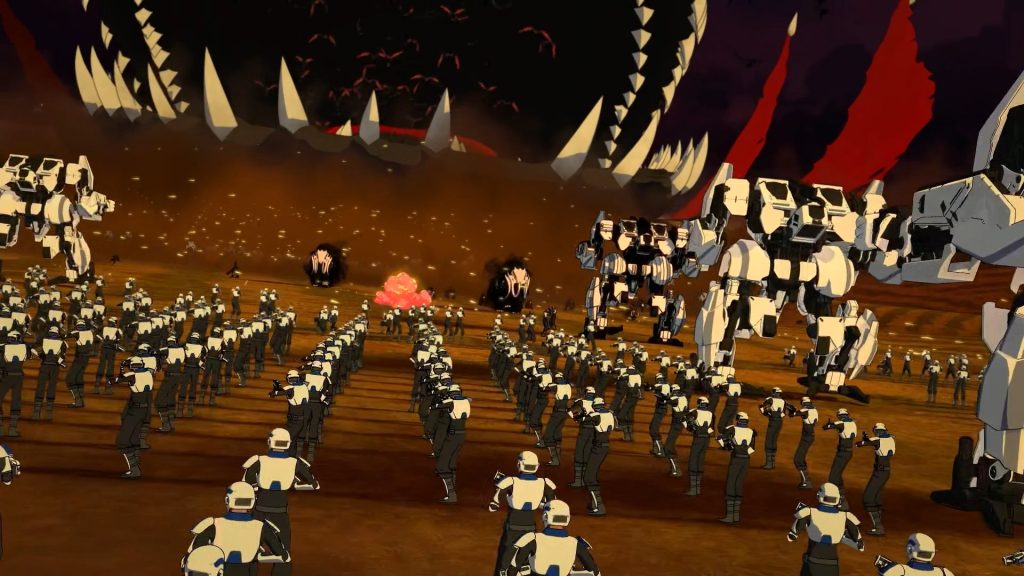
Volume 7
The good: Gorgeous visuals. Elaborate cinematography that takes full advantage of the 3D world. Does a good job of balancing the humorous and the serious. More coherent than previous volumes. Some absolutely stunning fights.
The bad: New character, vehicle, and monster designs are a real mixed bag. Tries to juggle too many characters instead of focusing on a few. Plot meanders and stumbles on some points, then does a sudden 180 that undoes what it just established.
The ugly: Jaune’s haircut.
Better on a binge rewatch? Six of one, half dozen of the other. It doesn’t have any of the issues of other volumes that make them either worse to watch piecemeal or a slog to get through all at once.
Volume 7 started strong, immediately wowing with impressive visuals and cinematography. The fights are pretty strong, though the best ones come later in the volume. Overall, it’s a lot more coherent than previous ones, with consistent visuals and more focused plot. The pace is breakneck, which is a double-edged sword. It keeps the energy up and prevents things from getting boring, but leaves almost no time for character development or team moments, which is a huge shame because there’s so much going on for them to respond to.
While the plot is more focused, it still stutters and leans on revelations that come out of nowhere, and it takes a wild turn two thirds of the way through. From what had already been spoiled for me, I’d expected Volume 8 to undo a lot of what Volume 7 set up, but I hadn’t expected Volume 7 to undo itself in the last third. It comes to a thematic conclusion and then flips around with all the characters unlearning their lesson literally ten minutes later. Once again, the volume almost redeems itself with some stunning fights, beautiful visuals, and great dramatic moments near the end, but it feels like it’s all happening because characters are doing what the plot demands rather than events unfolding organically and that puts a damper on everything.
Volume 8
The good: Some visually gorgeous scenes. Great character moments. Intense climactic ending with great fights.
The bad: Weird, often slow pacing. Struggles with a sense of scale. Focusing on a few characters means other character arcs are pushed offscreen.
The ugly: I see what they were trying to do with Klein, but it really didn’t work.
Better on a binge rewatch? Pretty much the same as V7; take your pick. I think it would have held together well as weekly episodes, without any that are intolerably weak.
Volume 8 feels like a continuation of the previous volume more than any other thus far. It picks up right where the last volume left off and keeps going with the same narrative threads. It’s visually stunning, just like the last volume, with some beautiful set pieces and intense fight scenes. It does get pretty dark toward the end, and I’m not sure if I’m a fan of that personally, but it’s handled pretty well.
One thing I noticed right away is that it spends a lot of time making up for the lack of character scenes in Volume 7, which is great, but it also gives the first half of the volume a weirdly slow pace. Volume 8 really does feel like it’s trying to make up for Volume 7’s issues, and while it does succeed in some ways, it’s still frustrating. There’s potential for two truly excellent volumes between the two, but instead they’re awkwardly split. We got weird pacing, echoing themes, victories that don’t feel earned and losses that don’t feel justified.
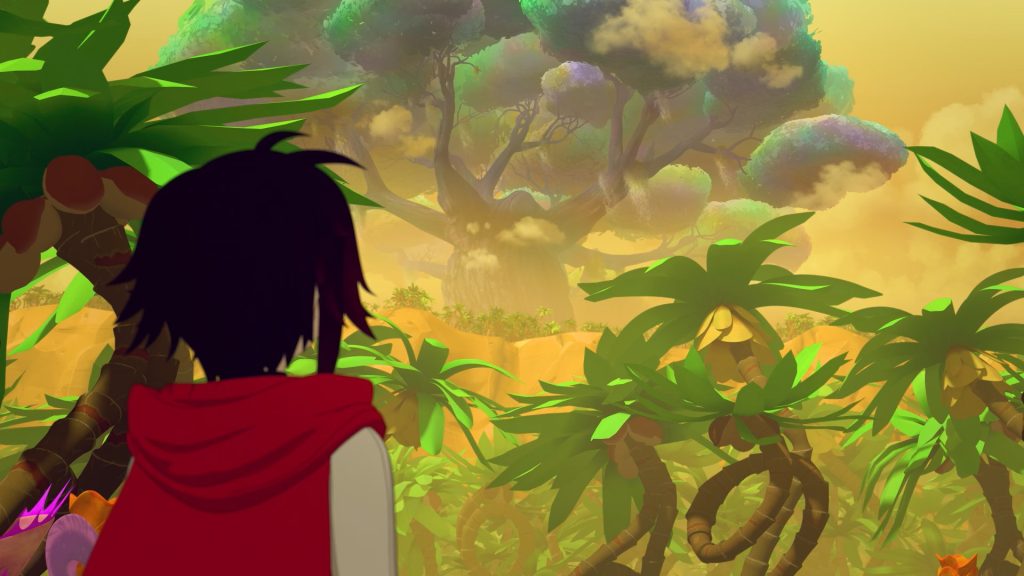
Volume 9
The good: Visually interesting. Slows down to really dive deep into some character arcs. Relatively even pacing, and keeps things interesting until the end. Audio engineering is improved. Great use of leitmotifs in music.
The bad: Less visual spectacle than previous volumes. Unimpressive fight scenes, and not many of them. Shortest volume since V2. Ending is dragged out just to provide unneeded exposition.
The ugly: Parts of the Ever After are less “Disney Wonderland” and more “Skyrim Ultra Low Settings Mod”.
Better on a binge rewatch? Yes. If you’d waited a year, you’d probably be getting frustrating wondering when the plot was going to start again.
I went into Volume 9 very skeptical. A volume-long bottle episode, more lore added to the pile, and a crazy genre shift? I’ve been told, though, that it’s one of the best volumes. After watching it, I think it’s a matter of perspective.
It’s essentially a long character study, which gives the show a chance to breathe, decompress, and address some character development that’s been a long time coming. I do think it fumbles things a bit toward the end, and I do think Ruby’s arc is the weakest despite being the focus, but in general it does a good job, all against a really unique and narratively interesting backdrop.
On the other hand, the main plot (and everything else) is completely stalled to go off on this tangent, and it feels indulgent in a way that ignores the reality of where the series was at, production wise. This is the season you make when ratings are high and you’re swimming in cash. It’s not the season you make when you don’t know how many seasons you have left. Rooster Teeth was already in dire straits by this point, and if the choice was between this or a Vacuo arc, I’d take the latter in a heartbeat. While it’s a lot more fun than Volume 4 was, it’s another case where the key points could have been condensed into an episode or two.
Quick Picks
Favourite volume: Either Volume 1, for its earnest jankiness, or Volume 3 on a rewatch for combining the early magic with later depths and increasing production values
Least favourite volume: Definitely Volume 4. While others are flawed, the fourth is the only one I found utterly boring.
Best opening theme: I thought it would be Time To Say Goodbye, but surprisingly, it’s Let’s Just Live that’s constantly stuck in my head. I really like the song on its own, maybe just not as the opening theme.
Best credits theme: Sacrifice, from Volume 2, which has been my favourite for a long time and hasn’t been dethroned. Nevermore comes really close, though.
Best girl: Nora. I love her chaotic energy and surprising depths.
In Summary
I think what struck me the most from my rewatch was how much RWBY evolved from Volume 1 to Volume 9, while at the same time in some ways was established firmly early on. If you put “Ruby Rose” and “Of Solitude And Self” beside each other, they’re worlds apart in terms of production values, yet they’re still recognizably the same show. RWBY would evolve in style, narrative, and tone, wrestle with genre shifts and worldbuilding, and step up dramatically in production quality. But several key elements- expressive and likeable characters, bright and colourful designs, intense fight scenes, and epic music- were established from the very beginning.
This isn’t per se a criticism of the series itself, but I was disappointed with the quality of the Blu-ray releases, both the Cinedigm and WB ones. The picture quality is good, probably the best of any way of viewing RWBY, but the audio mixing is poor, with crushed dialogue, flat music, and almost no surround effects, for all volumes except 9. One volume didn’t have subtitles available, another didn’t have a proper “movie” version, instead playing each episode with opening and closing titles. The Volume 1-6 set doesn’t include the special features discs for volumes that had them. I’m happy to own them, but I wish they were nicer.
In the next part, I’ll go deeper into what I think worked, what I think didn’t, and why that might have been. No ETA on that- it’s going to take a while to write, and I might take a detour to rewatch some of the side material. There will be a third part of this series, too, which will be all about how RWBY influenced me as a creator. I’ll definitely be talking about the FNDM as well, but I’m not sure yet whether that’s going to be in part 2 or part 3 or spread across both.
